Don't wanna be here? Send us removal request.
Text
Industrialization - Negative/Positive
5 Negative Effects
1. Environmental Disadvantages
By far, the biggest negative effect of industrialization is on the environment. Pollution is the most common by-product of industrialization. However, the degradation of ecological systems, global warming, greenhouse gas emissions, and the adverse effect on human health have garnered widespread concern. Because many industrialized companies are often not forced to pay damages for the environmental harm they cause, they tend to impose a major negative externality on human society in the form of deforestation, extinction of species, widespread pollution, and excessive waste.
2. Child Labour
During the Industrial Revolution poor children often worked full-time jobs in order to help support their families. Children as young as four years old worked long hours in factories under dangerous conditions. Some businesses hired children because they were cheap, worked hard, and could do some jobs that adults couldn't do. In some cases, the businesses treated the children no better than slaves. They kept them locked up and forced them to work long hours. In other cases, the businesses felt they were helping the children out by feeding them and keeping them from starving. The practice of child labour continued throughout much of the Industrial Revolution until laws were eventually passed that made child labour illegal.
3. Financial Disadvantages
The separation of capital and labour creates a wide gap in incomes between poor and rich due to a division of labour and capital. Those who own capital tend to accumulate excessive profits derived from their economic activities, resulting in a high disparity of income and wealth.
4. Unsafe Working Conditions
Factory work was dirty and dangerous. Bosses strictly disciplined their employees and treated them harshly. The workers were underpaid and overworked. They didn't get enough money for the labour they were providing. One also had a short life expectancy if they worked in a factory. The hours in a workday were very long too because the factories were indoors and didn't have to use sunlight to decide business hours. The government also provided no regulations for the treatment of businesses employees.
5. Social Disadvantages
Rapid urbanization brought on by industrialization typically leads to the general deterioration of workers' quality of life and many other problems for society, such as crime, stress, and psychological disorders. Long working hours usually lead to poor nutrition and consumption of quick and low-quality foods, resulting in increased incidences of diseases, such as diabetes, heart attack, and strokes.
5 Positive Effects
1. Goods Became More Affordable and More Accessible
Factories and the machines that they housed began to produce items faster and cheaper than could be made by hand. As the supply of various items rose, their cost to the consumer declined. Shoes, clothing, household goods, tools, and other items that enhance people’s quality of life became more common and less expensive. Foreign markets also were created for these goods, and the balance of trade shifted in favour of the producer—which brought increased wealth to the companies that produced these goods and added tax revenue to government coffers. However, it also contributed to the wealth inequality between goods-producing and goods-consuming countries.
2. The Rapid Evolution of Labor-Saving Inventions
The rapid production of hand tools and other useful items led to the development of new types of tools and vehicles to carry goods and people from one place to another. The growth of road and rail transportation and the invention of the telegraph (and its associated infrastructure of telegraph—and later telephone and fibre optic—lines) meant that word of advances in manufacturing, agricultural harvesting, energy production, and medical techniques could be communicated between interested parties quickly. Labour-saving machines such as the spinning jenny (a multiple-spindle machine for spinning wool or cotton) and other inventions, especially those driven by electricity (such as home appliances and refrigeration) and fossil fuels (such as automobiles and other fuel-powered vehicles), are also well-known products of the Industrial Revolution.
3. The Rapid Evolution of Medicine
The Industrial Revolution was the engine behind various advances in medicine. Industrialization allowed medical instruments (such as scalpels, microscope lenses, test tubes, and other equipment) to be produced more quickly. Using machine manufacturing, refinements to these instruments could more efficiently roll out to the physicians that needed them. As communication between physicians in different areas improved, the details behind new cures and treatments for disease could be dispersed quickly, resulting in better care.
4. Enhanced Wealth and Quality of Life of the Average Person
Mass production lowered the costs of much-needed tools, clothes, and other household items for the common (that is, nonaristocratic) people, which allowed them to save money for other things and build personal wealth. In addition, as new manufacturing machines were invented and new factories were built, new employment opportunities arose. No longer was the average person so closely tied to land-related concerns (such as being dependent upon the wages farm labour could provide or the plant and animal products farms could produce). Industrialization reduced the emphasis on land ownership as the chief source of personal wealth. The rising demand for manufactured goods meant that average people could make their fortunes in cities as factory employees and as employees of businesses that supported the factories, which paid better wages than farm-related positions. Generally speaking, people could save some portion of their wages, and many had the opportunity to invest in profitable businesses, thereby growing their family “nest eggs.” The subsequent growth of the middle class in the United Kingdom and other industrializing societies meant that it was making inroads into the pool of economic power held by the aristocracy. Their greater buying power and importance in society led to changes in laws that were updated to better handle the demands of an industrialized society.
5. The Rise of Specialist Professions
As industrialization progressed, more and more rural folk flocked to the cities in search of better pay in the factories. To increase the factories’ overall efficiency and to take advantage of new opportunities in the market, factory workers were trained to perform specialized tasks. Factory owners divided their workers into different groups, each group focusing on a specific task. Some groups secured and transported to the factories raw materials (namely iron, coal, and steel) used in mass production of goods, while other groups operated different machines. Some groups of workers fixed machines when they broke down, while others were charged with making improvements to them and overall factory operation.
As the factories grew and workers became more specialized, additional teachers and trainers were needed to pass on specialized skills. In addition, the housing, transportation, and recreational needs of factory workers resulted in the rapid expansion of cities and towns. Governmental bureaucracies grew to support these, and new specialized departments were created to handle traffic, sanitation, taxation, and other services. Other businesses within the towns also became more specialized as more builders, physicians, lawyers, and other workers were added to handle the various needs of the new residents.
Sources used:
https://www.investopedia.com/ask/answers/072815/what-are-some-drawbacks-industrialization.asp
https://www.ducksters.com/history/us_1800s/child_labor_industrial_revolution.php
https://sites.google.com/site/5effectsofindustrialization/effects-in-the-1800s-1900s
https://www.britannica.com/story/the-rise-of-the-machines-pros-and-cons-of-the-industrial-revolution
0 notes
Text
Artist Books
Pre - 2000
1. "Songs of Innocence and of Experience" by William Blake
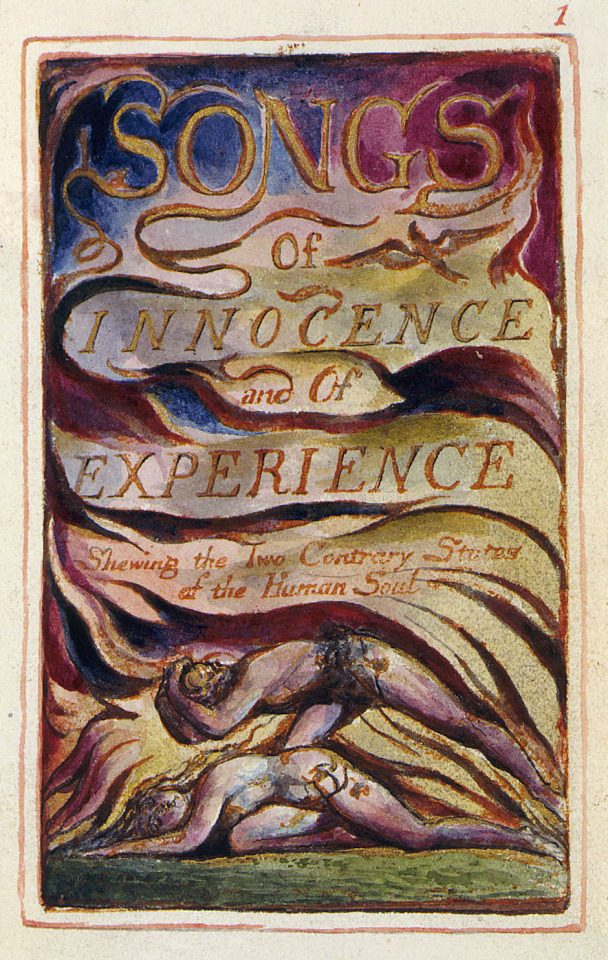
Songs of Innocence and of Experience is an illustrated collection of poems by William Blake. It appeared in two phases. A few first copies were printed and illuminated by William Blake himself in 1789; five years later he bound these poems with a set of new poems in a volume titled Songs of Innocence and of Experience Shewing the Two Contrary States of the Human Soul.
"Innocence" and "Experience" are definitions of consciousness that rethink Milton's existential-mythic states of "Paradise" and "Fall". Often, interpretations of this collection centre around a mythical dualism, where "Innocence" represents the "unfallen world" and "Experience" represents the "fallen world".Blake categorizes our modes of perception that tend to coordinate with a chronology that would become standard in Romanticism: childhood is a state of protected innocence rather than original sin, but not immune to the fallen world and its institutions. This world sometimes impinges on childhood itself, and in any event becomes known through "experience", a state of being marked by the loss of childhood vitality, by fear and inhibition, by social and political corruption, and by the manifold oppression of Church, State, and the ruling classes. The volume's "Contrary States" are sometimes signalled by patently repeated or contrasted titles: in Innocence, Infant Joy, in Experience, Infant Sorrow; in Innocence, The Lamb, in Experience, The Fly and The Tyger. The stark simplicity of poems such as The Chimney Sweeper and The Little Black Boy display Blake's acute sensibility to the realities of poverty and exploitation that accompanied the "Dark Satanic Mills" of the Industrial Revolution.
William Blake (28 November 1757 - 12 August 1827)
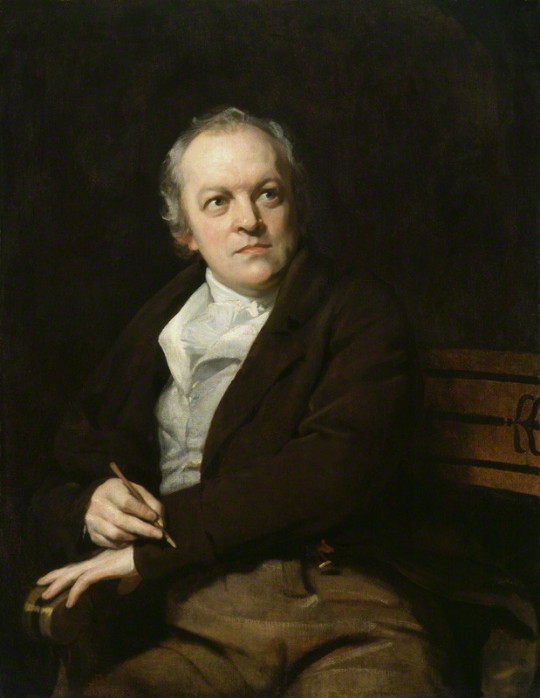
Poet, painter, engraver, and visionary William Blake worked to bring about a change both in the social order and in the minds of men. Though in his lifetime his work was largely neglected or dismissed, he is now considered one of the leading lights of English poetry, and his work has only grown in popularity. In his Life of William Blake (1863) Alexander Gilchrist warned his readers that Blake “neither wrote nor drew for the many, hardly for work’y-day men at all, rather for children and angels; himself ‘a divine child,’ whose playthings were sun, moon, and stars, the heavens and the earth.” Yet Blake himself believed that his writings were of national importance and that they could be understood by a majority of his peers. Far from being an isolated mystic, Blake lived and worked in the teeming metropolis of London at a time of great social and political change that profoundly influenced his writing. In addition to being considered one of the most visionary of English poets and one of the great progenitors of English Romanticism, his visual artwork is highly regarded around the world.
Because Blake's later poetry contains a private mythology with complex symbolism, his late work has been less published than his earlier more accessible work. The Vintage anthology of Blake edited by Patti Smith focuses heavily on the earlier work, as do many critical studies such as William Blake by D. G. Gillham.
The earlier work is primarily rebellious in character and can be seen as a protest against dogmatic religion especially notable in The Marriage of Heaven and Hell, in which the figure represented by the "Devil" is virtually a hero rebelling against an imposter authoritarian deity. In later works, such as Milton and Jerusalem, Blake carves a distinctive vision of a humanity redeemed by self-sacrifice and forgiveness, while retaining his earlier negative attitude towards what he felt was the rigid and morbid authoritarianism of traditional religion. Not all readers of Blake agree upon how much continuity exists between Blake's earlier and later works.
Psychoanalyst June Singer has written that Blake's late work displayed a development of the ideas first introduced in his earlier works, namely, the humanitarian goal of achieving personal wholeness of body and spirit. The final section of the expanded edition of her Blake study The Unholy Bible suggests the later works are the "Bible of Hell" promised in The Marriage of Heaven and Hell. Regarding Blake's final poem, Jerusalem, she writes: "The promise of the divine in man, made in The Marriage of Heaven and Hell, is at last fulfilled."
John Middleton Murry notes discontinuity between Marriage and the late works, in that while the early Blake focused on a "sheer negative opposition between Energy and Reason", the later Blake emphasised the notions of self-sacrifice and forgiveness as the road to interior wholeness. This renunciation of the sharper dualism of Marriage of Heaven and Hell is evidenced in particular by the humanisation of the character of Urizen in the later works. Murry characterises the later Blake as having found "mutual understanding" and "mutual forgiveness".
Other Works:

1. The archetype of the Creator is a familiar image in Blake's work. Here, the demiurgic figure Urizen prays before the world he has forged. The Song of Los is the third in a series of illuminated books painted by Blake and his wife, collectively known as the Continental Prophecies.
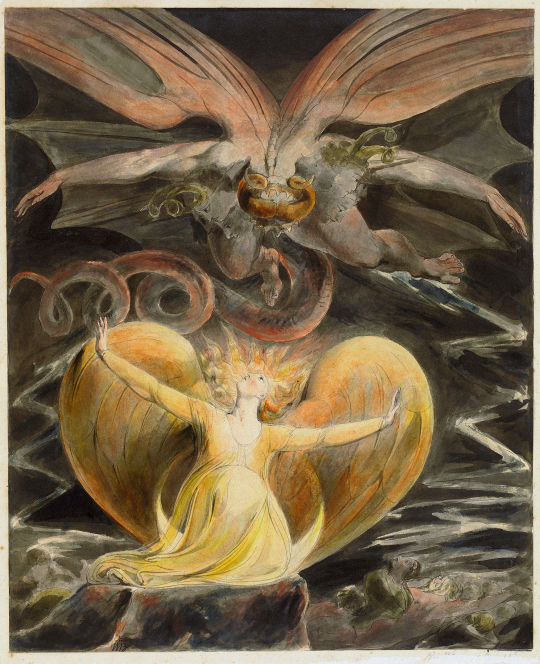
2. Blake's The Great Red Dragon and the Woman Clothed with Sun (1805) is one of a series of illustrations of Revelation 12.

3. The Ghost of a Flea, 1819–1820. Having informed painter-astrologer John Varley of his visions of apparitions, Blake was subsequently persuaded to paint one of them. Varley's anecdote of Blake and his vision of the flea's ghost became well-known.

4. The Night of Enitharmon's Joy, 1795; Blake's vision of Hecate, Greek goddess of black magic and the underworld.
2. "Investigations—The Four Elements: Earth" by Daniel E. Kelm and Timothy C. Ely
The series of unique books Investigations: The Four Elements draws upon Kelm’s and collaborator Tim Ely’s shared interest in alchemy and sacred geometry. Each book consists of a set number of interlocking panels that can be assembled into one or more shapes forming Platonic solids.
The Platonic solids—tetrahedron, cube, octahedron, dodecahedron, and icosahedron—are polyhedrons with congruent sides, edges, and angles. Although these five shapes were known prior to Plato, they are specifically mentioned in his dialogue Timaeus. In this work, Plato describes these solids as the building blocks of matter, equating the tetrahedron with the element of fire, the cube with earth, the octahedron with air, the icosahedron with water, and the dodecahedron with the materials that form the stars and the cosmos.

The closed box.
Book sculpture by Kelm.
Painting and surface treatments by Ely.
Acrylic and ink on paper, with airbrush acrylics, aluminium, brass tubing and rod, thread, and wire edge binding.

A first glimpse inside the box reveals shaped page panels and a metal tube with paper wrapped around it.
One slot in the box holds the square page panels and a second slot holds the triangular page panels.
The Investigations series is the earliest example of Kelm bindings with no permanent hinging; i.e., the pins can be removed and the pages completely disassembled.
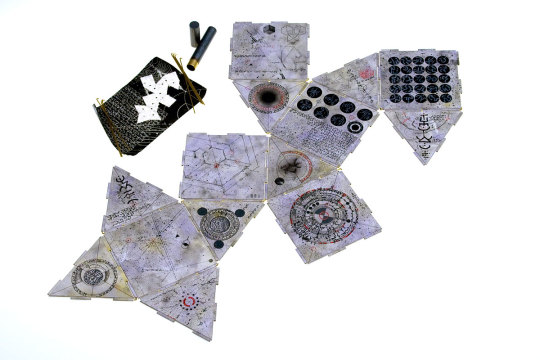
The metal tube contains the pins that will be used to hold the binding together.
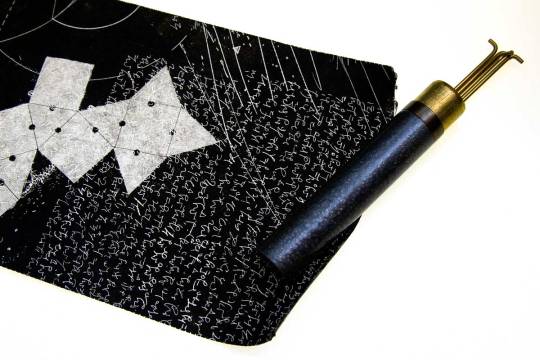
The paper scroll depicts a possible configuration of pages.

Here you see all the pages combined to form a cube-octahedron—which means that it is an integration of a cube and an octahedron.
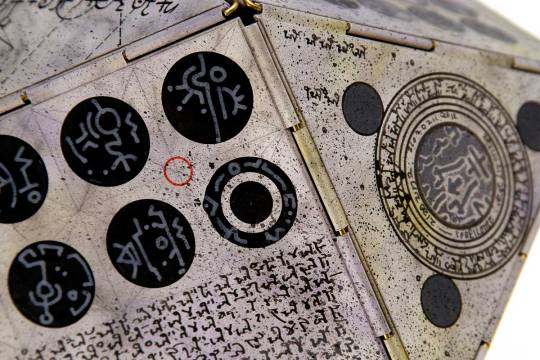
Detail of the painting and hinging.
Daniel Kelm
Daniel Kelm is a book artist, sculptor, book binder, and teacher. His intricate, detailed works invite unconventional ways of reading—which can resemble unearthing a mystifying treasure or solving a 3-D puzzle—and they condense wondrous topics that have laid between book covers for centuries—like alchemy, mathematics, science, metaphysics, maps, and illustrations—within visually astonishing bindings.
He invented the widely-used “wire-edge binding” and is the founder and proprietor of Wide Awake Garage studio in Easthampton, Massachusetts, where he designs and produces artist’s books and innovative sculptural bindings. His work has been shown nationally for over thirty years, and he has taught and lectured at universities and libraries in the U.S. and Europe.
Interview:
Lyra Kilston: Your work expands the form of what most people think of as a book: your works don’t need words, or images, or to open in an arc. In your view, what is the outer limit of having something remain a ‘book’?
Daniel Kelm: Books are a wonderful vehicle for telling stories. Most often the book artist constructs the book around their or an author’s story. Many of my books contain no recognizable words but are made of shapes that allow wide-ranging flexibility and movement. They are actually quite toy like, and if successful engage the “reader” in the same physical and interactive way as do toys. During that play, these wordless books can inspire someone to discover their own voice and story. I love watching someone interact with one of my sculptural books, then suddenly stop to tell one of their own stories.
What are some of your favourite materials to work with?
I love working with vegetable-tanned goat skin, a material commonly used in traditional fine bookbinding. For non-traditional work I tend towards metal, glass, and plastic. I’ve not found any material to be too rare or impossible to find and work with; there is always a way to invite it to play. In all cases, whatever the material used, it is important to discover its voice and to let that voice support the story being told.

Mars, 1991–2005, Daniel Kelm. 11.5 x 8 x 3 in. (closed). Contents: box, accordion book partially pinned together, and three objects representing various aspects of Mars. Materials: paper board, paper, acrylic paint, thread, stainless steel wire, dry-mount adhesive, iron nickel meteorite, chrome steel ball bearing, Civil War iron canister ball, felt, fibre board, cloth. Techniques: wire edge binding, painting, photocopy transfer, airbrush, paste paper, silk screen printing, letterpress printing. Voice of Mars text by Taz Sibley. Letterpress printing by Art Larson.
What themes have you been working with recently?
After 20 years immersed in chemistry, I began a thirty-year study of alchemical processes that has inspired many of my artist’s books and sculpture. Experimentation with plant alchemy (spagyric alchemy) led me to an appreciation of pharmacy. In my latest work I’m exploring chemical and pharmaceutical processes through installations combining laboratory apparatus with antiquarian books describing the process.
I look at the installations as functional sculpture. The animating voice of each piece is that of the chemist, pharmacist, researcher, or lab worker who developed and explained the particular approach, so their name is usually intimately associated with it.
What is your research process like?
I often start with a description of a process or an image of the associated apparatus and then find out everything that I can about it, including details about the life of the person who developed it. My work always tries to integrate the personal connection (through the life of the individual associated with the science involved), the historical (by choosing a process that has been proven through its historical record to be significant to our lives), the aesthetic (as seen in its sculptural quality), and the technical (the details of the process and materials themselves).

Relgio Mathmatica, 1990–2007, Daniel Kelm. 9 x 9.5 x 9.5 in. Materials: paper and paper board, stainless steel wire, thread, English yew wood, paint, leather. Techniques: wire edge binding, spattering, paste paper. Photographer: Jeff Derose, One Match Films. Binding assistance by Kylin Lee. This video of Kelm manipulating the binding shows how the “Lotus Flower” configuration closes—the red cube moves to the inside, and the black and white surfaces to the outside.
Sources used:
https://en.wikipedia.org/wiki/Songs_of_Innocence_and_of_Experience
https://en.wikipedia.org/wiki/William_Blake#Development_of_his_views
https://www.poetryfoundation.org/poets/william-blake
http://www.danielkelm.com/core/wideawake/3/1#/galleries/2
http://www.danielkelm.com/core/wideawake/3#/entry/wide-awake-garage-videos
https://blogs.getty.edu/iris/alchemical-book-artists-at-work-part-2-daniel-kelm/
Post - 2000 Artist Books
1. "Don't Lose Heart" by Anne Gilman

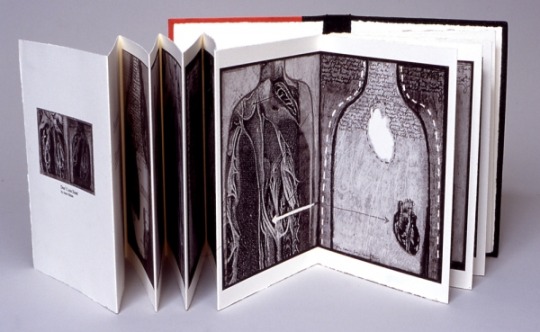
Don't Lose Heart 2001 mixed media digital accordion book printed on Arches cover stock, edition of 10 9" x 6" x 1" Don’t Lose Heart contains a play on expressions we use with the word "heart". Below is the text that appears at the end of the book:
You can have a change of heart, a heart of gold, a heavy heart, a heart to heart.
You can eat one’s heart out, lose heart, have a heart, take heart.
In my heart of hearts, with a heavy heart, cross my heart, from the bottom of my heart, Don’t lose heart.
Anne Gilman

Anne Gilman is a Brooklyn-born artist who works in varying formats that include large-scale drawings and multi-panel projects. The political, social and personal concerns that fuel all forms of moods, worries, and psychological states of being are the materials that feed her work. She begins by using her own thoughts and experiences as a starting point for considering larger issues of why we do what we do, what matters and how we can get lost in distractions that are ultimately unimportant. The resulting drawings are a mapping of information, thought and emotion.
Other Works:
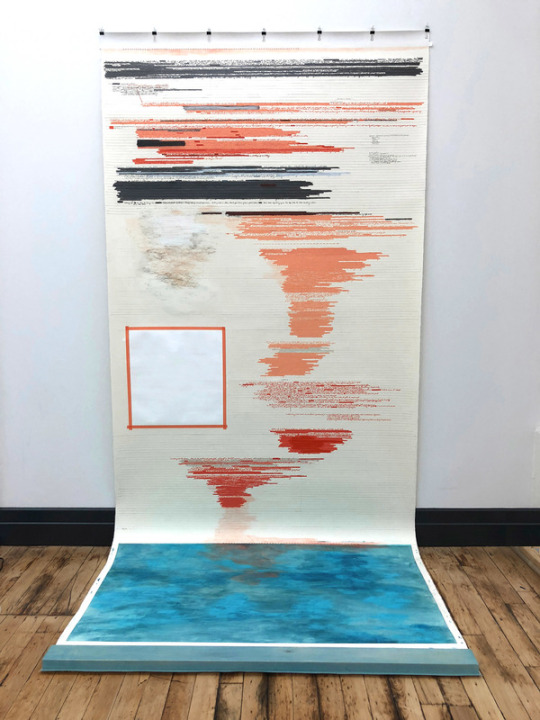
Sundowning 2018 pencil, graphite, paint, tape, ink, on paper with hand-stained wood 134 x 60 inches
Sundowning (also known as a sundown syndrome) = a neurological phenomenon associated with increased confusion and restlessness in patients with dementia. It occurs in the late afternoon/early evening. Symptoms include increased agitation; a person may become more upset/anxious/confused/disoriented/suspicious
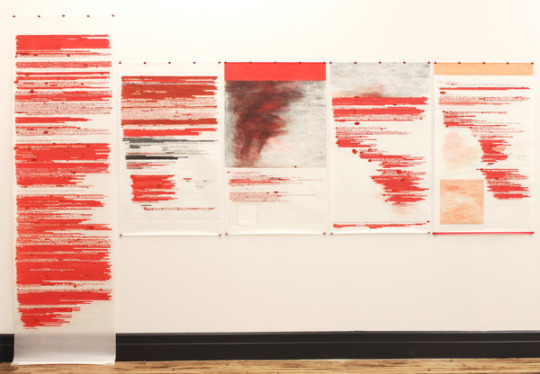
Boiling point (5 works in this series) 2018 ink, pencil, tape on mulberry paper One section is 94½ x 27½ inches and the other four are 46 x 27½ inches
“A part of the writing in these drawings focus on issues of anger and rage. I was thinking about the levels of discontent that people live with, whether triggered by relatively insignificant incidents or by a build-up of frustration over time, and the need for an appropriate outlet to diffuse and address the intensity, before it erupts in explosive ways.” A. Gilman

this place / this hour 2019 Coloured pencil, graphite, ink, and washi tape on mulberry paper 321 x 27 inches
“I was invited to do a project commemorating the 200th anniversary of Walt Whitman’s birth. My research resulted in this two-sided 27-foot scroll and a limited-edition artist book. In both projects Walt Whitman’s words, process and internal struggles are intertwined with my own. This scroll is suspended from the ceiling and extends across the floor in two directions. This view shows the non-text side of the scroll on the left side and the text-based side of the scroll on the right side.” A. Gilman
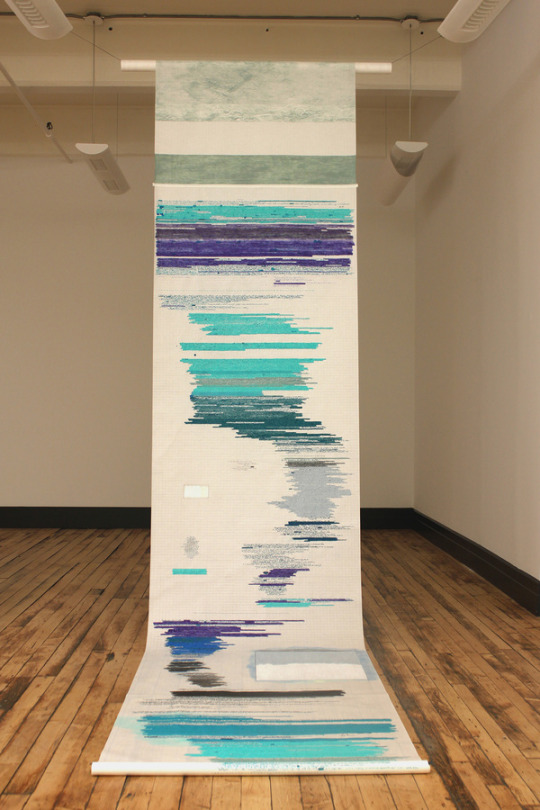
Up close / in the distance / now 2018 pencil, graphite, tape, ink, BIC ballpoint pen, matte medium on mulberry paper 340 x 38 inches
This scroll suspends from the ceiling with one side showing primarily the text part of the work and the other side showing non-text drawing. This view shows the text side. The next two images show other views.

Up close / in the distance / now 2018 pencil, graphite, tape, ink, BIC ballpoint pen, matte medium on mulberry paper 340 x 38 inches
This view shows the scroll from the side. The next view shows the non-text side of the drawing.
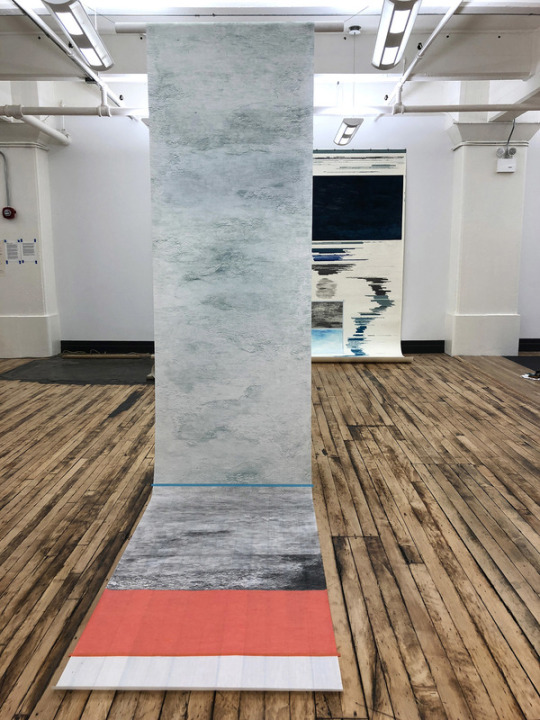
Up close / in the distance / now 2018 pencil, graphite, tape, ink, BIC ballpoint pen, matte medium on mulberry paper 340 x 38 inches
This is a view of the non-text side of the drawing.
2. “Second Road” by Timothy C. Ely
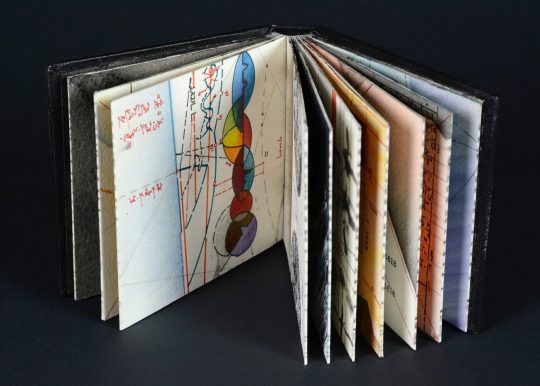
Second Road, 2016, Timothy C. Ely. Drum leaf binding, full leather, watercolor, dry pigments, gold and ink on paper. All images in this post courtesy of the artist.
Timothy C. Ely
Ely studied design and printmaking and has been making books for over forty years. (He also owns sixty books on baking bread, his other passion that relies on precision and a bit of alchemical magic.) He has shown his work at museums around the country and it is in many private and public collections.
Interview:
Lyra Kilston: Do you have a favorite rare or ancient book? Have you been able to see it in person?
Timothy Ely: The Gutenberg forty-two-line Bible, which I saw in New York’s public library. I have handled this book, and revel in the idea that it is a point on the historical timeline where we switched over from the book as a handmade ideal to an industrial product. My work is embedded in the ideas of pre-Gutenberg technology, with as much of the production being done by hand and the content generated by long contemplation and the intuitive handling of method.
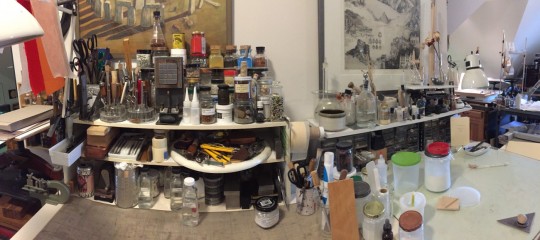
Timothy C. Ely’s studio, 2016.
You work with fascinating materials, like animal skin bindings and nineteenth-century paints. What are a couple of your favorite materials to work with? Is there a material that you’d love to work with, but it’s too rare or obsolete?
I envision making a large vellum book using a contemporary variant on an old technology. I have a vellum model in the works which has been in the press for sixteen years. Vellum is expensive and requires much animal husbandry to provide foliation for the artist. This book-to-be needs patronage.
Other favorites are rare pigments made of materials from obscure locations. Not so much for what they materially do but what associations are formed. Meteoric dust (I have some from a meteor that fell around the time of Columbus), sand from Asian deserts, soil from the gardens of bookbinders and monasteries. My collection is vast and my spies numerous. This material adds form to covers but on occasion finds its way into the interior.
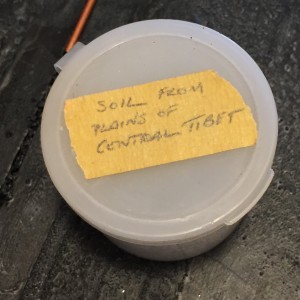
Soil from the plains of Central Tibet, one of many unique materials in Ely’s studio.
Your work takes inspiration from a range of sources, from ancient runes to science fiction to the spiral pattern on a pine cone. What themes have you been working with recently?
I am attempting to render the invisible, to describe some ideas like 4-D architectural renderings and diagrams of the ineffable. By using well-tested ideas such as symbolic visual descriptions, I can make an foray into how we might imagine the path of a particle or a hunch.
What is your research process like?
My process is to draw, fail, evaluate, draw again, erase, redraw, abandon hope, find the path again, read something, draw more, melt something or hammer it together, fuse things, make some bread, draw again, and continue to see what shows up. Often up, sometimes down—it is never a linear process, but one that works by continuing to work with purpose against a plane which cannot easily be scaled.

The Observatory, 2006, Timothy C. Ely. Ink, gouache, and dry pigment on paper.
Sources used:
https://www.annegilman.com/
https://www.annegilman.com/artist-books/limited-edition-artist-books/view/57
https://www.annegilman.com/artist-books/limited-edition-artist-books/view/58
https://www.annegilman.com/scroll-drawings/scrolls-on-and-off-the-wall/1
https://www.annegilman.com/scroll-drawings/scrolls-on-and-off-the-wall/2
https://www.annegilman.com/scroll-drawings/scrolls-on-and-off-the-wall/6
https://www.annegilman.com/scroll-drawings/scrolls-on-and-off-the-wall/3
https://www.annegilman.com/scroll-drawings/scrolls-on-and-off-the-wall/4
https://www.annegilman.com/scroll-drawings/scrolls-on-and-off-the-wall/5
https://blogs.getty.edu/iris/alchemical-book-artists-at-work-part-1-timothy-c-ely/
3 notes
·
View notes





